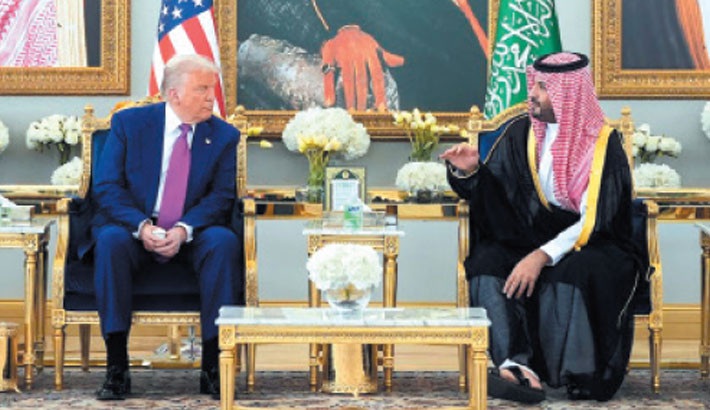Trump’s Gulf Tour Signals Strategic Realignment in US Middle East Policy
Adam O. Erol [Source : Daily Sun, 14 May 2025]

Adam O. Erol
U.S. President Donald Trump’s visit to Saudi Arabia, the United Arab Emirates (UAE) and Qatar from 13 to 16 May represents more than a series of diplomatic meetings. It signals a strategic recalibration of US foreign policy in the Middle East, shifting focus from military intervention to economic partnership and regional diplomacy. This approach underlines the ongoing evolution of US interests in a region marked by volatility, competition and enduring geopolitical significance.
Economic engagement at the forefront
Central to Trump’s itinerary is pursuing substantial economic investments from Gulf nations into the US economy. The administration has introduced a “fast track” investment process designed to streamline foreign investments from allied countries, a move welcomed by Gulf States controlling some of the world’s most significant sovereign wealth funds. The UAE has announced plans to invest $1.4 trillion in the US over the next decade – a bold commitment that underscores deepening economic ties between the two nations.
Furthermore, Washington has granted preliminary approval for a $3.5 billion arms deal with Saudi Arabia involving advanced air-to-air missiles and associated support equipment. While arms sales continue long-standing US-Saudi defence cooperation, their timing, just days before Trump’s arrival, suggests a deeper integration of economic and strategic priorities.
Strategic diplomacy amid regional tensions
Leaders of the Gulf Cooperation Council have been invited by Saudi King Salman bin Abdulaziz Al Saud to attend a Gulf-US summit in Riyadh, as part of Trump’s Middle East tour, where they will likely discuss critical regional issues such as the humanitarian crisis in Gaza, instability in Lebanon and the fragile post-conflict recovery in Syria.
Trump’s trip also provides an opportunity for Israel and the UAE to reaffirm their commitment to the Abraham Accords – bilateral agreements on Arab-Israeli normalisation – and build momentum for Israel to normalise relations with other Arab states.
Notably, Trump’s administration plans to adopt the term “Arabian Gulf” instead of the traditionally used “Persian Gulf” – a symbolic move aligning more closely with Arab allies and signalling a diplomatic pivot that could inflame tensions with Iran. Though largely rhetorical, the change carries significant geopolitical implications, potentially realigning perceptions of US neutrality in intra-regional rivalries.
Trump’s choice of Saudi Arabia, the UAE and Qatar reflects their status as the pillars of US engagement in the Gulf. Each country holds strategic military bases, contributes to regional counterterrorism efforts and plays a role in energy security. Qatar, host of the largest US military installation in the Middle East – Al Udeid Air Base – remains a critical node in Washington’s forward deployment strategy.
Meanwhile, Saudi Arabia and the UAE remain primary energy and defence partners. Trump is expected to push for deeper infrastructure and energy security coordination, particularly given recent disruptions in global oil markets. These engagements are not merely transactional; they represent Washington’s efforts to solidify long-term alliances amid the growing assertiveness of non-regional actors.
Implications for broader US foreign policy Trump’s visit signals a broader shift in how the US projects power abroad. Rather than relying solely on troop deployments or coercive diplomacy, Washington is leaning into economic influence and soft power to achieve its foreign policy goals. The administration’s recalibration reflects lessons learned from the post-9/11 era and wars in Iraq and Afghanistan, where military dominance failed to yield lasting political outcomes.
Moreover, this tour sends a message to global observers that the US is neither retreating from the Middle East nor content with the status quo. Instead, it is engaging in a selective realignment emphasising partnerships with capable, wealthy allies who can help shoulder regional burdens. By concentrating on economic and diplomatic initiatives, Trump hopes to create a more sustainable and multilateral approach to maintaining US influence in the region.
Despite its strategic aspirations, the trip is not without controversy. Some argue that bypassing broader regional players, including Turkiye, Egypt and Jordan, risks alienating important stakeholders and reducing the effectiveness of a cohesive regional strategy. Still, the Trump administration focuses on countries with which it can secure immediate and substantial economic and security benefits.
President Trump’s Gulf tour marks a turning point in US Middle East policy. Prioritising economic diplomacy, symbolic gestures and strategic realignment, his trip reflects a pragmatic and potentially more sustainable approach to engaging with a region in flux. Whether it yields long-term stability or merely reaffirms transactional ties remains to be seen. However, one thing is clear: the US is recalibrating its role in the Middle East to reflect a new era of global competition, where military might, investment flows and diplomatic agility increasingly measure influence.
The writer is an international relations analyst who specialises in Middle Eastern geopolitics and US foreign policy
Courtesy: CGTN